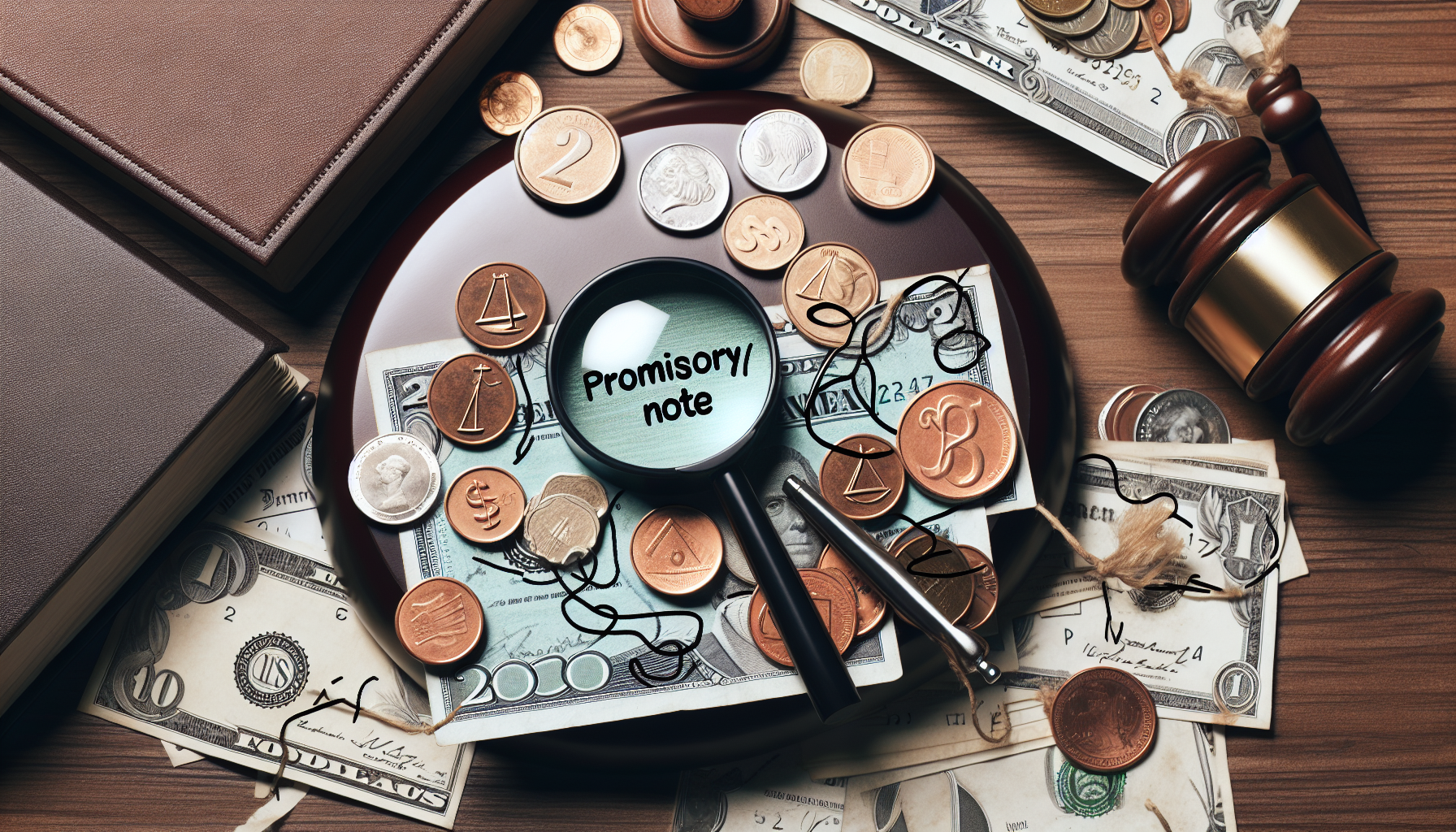Short Summary
The Florida promissory note requirements include the amount borrowed, repayment terms, interest rate, parties’ names, and signatures. It should also specify collateral if secured, and be in writing for enforceability. Legal compliance with Florida’s interest rate laws is essential.
Introduction & Background
With my extensive background in corporate law, particularly in real estate and venture capital transactions, I bring a seasoned perspective to the drafting and understanding of legal documents. In this article, I delve into the nuances of Florida promissory notes, a critical tool in financial transactions.
If you’re dealing with a promissory note in Florida, it’s imperative to get the details right. Florida promissory note requirements are precise, with no room for error. Within this article, you’ll find clear guidance on the essential legal elements — from party identification to payment schedules — that make your note valid and binding.
My experience, gained at reputable firms like Lowndes, Drosdick, Doster, Kantor & Reed, P.A., and Locke Lord LLP, equips me to guide you through the intricate requirements of these notes. From the essential elements of party identification and payment schedules to the subtleties of legal compliance, this article aims to provide a comprehensive understanding of how to create valid and binding promissory notes in Florida, ensuring your financial dealings are legally sound and effective.
Key Takeaways
- Florida promissory note requirements include accurate identification of the parties, clear loan terms, and a structured repayment plan to be legally valid, and may include a secured form to protect the lender.
- Legal compliance is crucial when drafting promissory notes. The Florida promissory note requirements explicitly list adhering to interest rate caps, incorporating attorney’s fees provisions, and understanding the role of collateral and security interests to mitigate lender risk.
- When calculating the cost of a loan in Florida, one must include tax obligations such as documentary stamp tax and nonrecurring intangible tax, in addition to ensuring that the promissory note is carefully drafted, possibly with professional assistance, for both legal compliance and specificity to the loan agreement.
Essential Elements of a Florida Promissory Note

We start our exploration of the various Florida promissory note requirements by getting to know the notes core elements. Much like the backbone supports the human body, these elements form the structural framework of a promissory note, giving it stability and legal validity.
A Florida promissory note is characterized by three key aspects: the identification of parties, the specification of loan terms, and the structuring of a repayment plan. Each of these elements plays a pivotal role in shaping the nature of the personal promissory note and defining the borrower’s obligations and the lender’s rights. In some cases, a secured promissory note may be used to provide additional protection for the lender.
We will now further examine each of these important elements.
Identifying the Parties
Creating a promissory note begins with the identification of the participants, namely the borrower and the lender. It may seem like a simple task, but it is of utmost importance. Imagine embarking on a journey without knowing who your travel companions are. Could lead to some unexpected surprises, right?
The same principle applies to promissory notes. If the parties are inaccurately identified, it can lead to disputes and potentially impede the lender’s capacity to seek repayment of the outstanding balance. To avoid this, Florida promissory note requirements state that the note must include the complete names and addresses of both the borrower and the lender. If there are multiple lenders or borrowers, all parties should be properly identified.
Stating the Loan Terms
Defining the loan terms is the subsequent vital step in creating a promissory note. This involves outlining:
- The principal loan amount
- The date of creation of the note
- The repayment schedule
- The interest charged on the loan
It’s akin to plotting the course of our journey, determining where we’re heading, and estimating how long it will take to reach our destination.
It’s important to clearly define these terms as they form the basis for a precise, legally binding documentation of the loan agreement and the borrower’s commitments. This aids in elucidating the loan terms and the repercussions in the event of payment default. So, it’s crucial to avoid common errors such as:
- Incomplete signatures
- Omission of payment amount or schedule
- Absence of interest rate
- Failure to include comprehensive loan terms.
Structuring the Repayment Plan
Having identified the parties and outlined the loan terms, we now focus on the formulation of the repayment plan, a key aspect of any promissory note. Repayment plans can be structured through a variety of clauses that outline conditions such as:
- Installment payments
- Lump-sum payments
- Due dates
- Any special conditions of the agreement
The structure of a loan is flexible and can adapt to the borrower’s financial situation and the lender’s preferences. It could include:
- Lump sum repayment
- Installment payments
- Balloon payments
- Interest-only payments
For example, an installment repayment plan delineates the precise amount of each due installment payment, the frequency of payments, and the duration of the repayment period. It’s like planning how and when to refuel your vehicle during a road trip to ensure you reach your destination without running out of gas.
Securing the Promise: Collateral and Security Interests

Our next focus is on understanding the ways to ensure the promise of repayment is secured. Much like securing your belongings before embarking on a journey, securing a promissory note involves using collateral and creating a security interest. These elements serve as safeguards for the lender, mitigating the risk of losses in case the borrower defaults on their unsecured promissory note.
Collateral refers to a tangible asset that can be seized in case the borrower fails to repay the loan, while a security interest is a legal claim or lien on the collateral, protecting the lender’s investment. It’s akin to having insurance for your journey, ensuring you’re covered if anything goes wrong.
The Role of Collateral
Imagine going on a journey and leaving your valuable belongings behind as a guarantee that you’ll return. That’s exactly what collateral does in a promissory note. It’s a tangible asset, like real estate or business interests, that the borrower pledges to secure the loan.
In the event of borrower default, the lender has the legal right to to seize the collateral to fulfill the outstanding loan amount. This acts as a safety net for the lender, protecting their investment. So, it’s important to be clear about the nature and value of the collateral to avoid potential disputes.
Creating a Security Interest
Creating a security interest in a promissory note is like having a map for your journey. It’s the lender’s legal claim or lien on the collateral, which ensures their priority over other creditors in case of default.
The process of creating a security interest can vary, but it generally involves the lender taking possession of the collateral or filing a document that publicly declares their ownership interest in the collateral. It’s the compass that guides the lender, ensuring they have a legal right to the collateral if things go south.
Legal Considerations and Statutory Compliance

Drafting a promissory note, akin to adhering to traffic rules, necessitates compliance with certain legal regulations and statutes. In Florida, these primarily include adhering to interest rate caps and understanding attorney’s fees provisions as per the Florida Statutes.
The law caps interest rates to protect borrowers from predatory lending practices, while the attorney’s fees provisions clarify who will bear the legal costs in case of enforcement. These legal considerations are like the rulebook for our journey, ensuring that everything goes smoothly and everyone stays safe.
Adhering to Interest Rate Caps
Adhering to interest rate caps in a promissory note is like sticking to the speed limit on a road trip. It’s not just a suggestion, it’s the law. In Florida, the maximum interest rate for loans under $500,000 is 18 percent, and for loans over $500,000, it’s 25 percent.
Charging interest rates above these caps can lead to severe penalties. For instance, a rate exceeding 25 percent but less than 45 percent is considered a misdemeanor, while any rate surpassing 45 percent is classified as a third-degree felony. So, it’s crucial to abide by these caps to ensure a smooth journey and avoid any legal roadblocks.
Understanding Attorney’s Fees Provisions
Understanding attorney’s fees provisions is like knowing who’s going to pay for gas on a road trip. It’s important to clarify this upfront to avoid any disputes later on. In a Florida promissory note, the attorney’s fees provision specifies who will cover the legal costs in case of enforcement.
Florida law allows the reimbursement of reasonable attorney’s fees as long as it’s specified in the agreement and not forbidden by law. So, whether you’re the borrower or the lender, understanding the provisions related to reasonable attorney’s fees can help you navigate potential legal costs and keep your journey on track.
Additional Clauses and Agreements

Our exploration of Florida promissory note requirements extend beyond just the legal considerations. There are additional clauses and agreements that can be included in a promissory note to provide more clarity and protection for both parties. These include late payment penalties, prepayment provisions, and acceleration and default clauses.
Think of these additional clauses as the extra supplies you pack for a road trip. They might not always be necessary, but they can come in handy in certain situations and make your journey smoother.
Late Payment Penalties
Just like you might pay a late fee for returning a rental car past the due date, late payment penalties apply when the borrower fails to make a scheduled payment on time. These penalties are enforced when a borrower fails to make a payment as per the agreed schedule.
The late fee is typically a percentage of the overdue payment and can’t be levied for payments that are less than 15 days late. It’s like a gentle reminder for the borrower to stay on top of their payments and keep the journey on track.
Prepayment Provisions
Just as you might want to return your rental car early to save on rental fees, prepayment provisions allow the borrower to repay the loan before its due date. But unlike rental car fees, prepayment can sometimes result in penalties, depending on the terms of the note.
Prepayment provisions are usually structured to permit the borrower to prepay the note in full or in part without incurring any penalty. It’s like getting a free pass to finish your journey early if you wish to.
Acceleration and Default
The final additional clause among the Florida promissory note requirements we’ll discuss is the acceleration and default clause. This is like the emergency brake in a car. It’s only used when something goes wrong, and in the case of a promissory note, it’s used when the borrower fails to meet the terms of the note.
The acceleration clause allows the lender to demand immediate repayment of the entire outstanding loan balance in the event of a default, such as non-payment or breach of other terms. The default clause outlines the repercussions if the borrower fails to fulfill their payment obligations. It’s like a safety measure to protect both parties in case of unexpected bumps in the road.
Tax Obligations Related to Promissory Notes

Similar to unavoidable toll booths on a journey, there are certain mandatory tax obligations associated with promissory notes. In Florida, these taxes include the documentary stamp tax and the nonrecurring intangible tax.
These taxes are like the toll fees you pay for using certain roads. They might seem like a hassle, but they are part of the journey of drafting a Florida promissory note and contribute to the overall cost of the loan.
Documentary Stamp Tax Requirements
The documentary stamp tax is a state tax imposed on certain loan transactions, including promissory notes. It’s like a toll fee for using the ‘promissory note highway’. The tax is currently set at 35 cents for every $100 loaned.
Just like not paying a toll fee can result in a fine, failing to pay the documentary stamp tax can lead to a first-degree misdemeanor charge and financial penalties. So, it’s crucial to factor in this tax when calculating the total cost of your loan.
Navigating Nonrecurring Intangible Taxes
The nonrecurring intangible tax is another ‘toll fee’ that applies to loans secured by real property in Florida. This tax is levied on obligations to pay money that is secured by a mortgage.
The tax is determined by applying a rate of 2 mills for each dollar of the just value of the note secured by the mortgage. Much like the documentary stamp tax, the nonrecurring intangible tax contributes to the overall cost of the loan and should be considered when calculating the total amount to be repaid.
Drafting to Adhere to Florida Promissory Note Requirements: Practical Tips
Having explored the fundamentals of a Florida promissory note, we can now share some practical insights for drafting one. Although a template can serve as a foundation for drafting a promissory note, customizing it is crucial to accurately represent the specifics of the loan agreement.
Given the intricate nature of promissory notes and their legal ramifications, it’s often advisable to enlist professional assistance for drafting one. This can help ensure that the note complies with Florida law and protects both the lender and the borrower.
Template vs. Custom Drafts
Using a template can be a good starting point when drafting a promissory note, which is a type of written document. It’s like using a pre-planned itinerary for your journey. But just like every journey is unique, every promissory note is unique too, and customization is necessary to ensure it accurately reflects the agreement between the lender and the borrower.
Although templates contain standardized language that covers the basic terms of a promissory note, it might not accommodate specific state laws and regulations, and essential terms relevant to your agreement may be excluded. Therefore, it’s important to customize the template to your specific needs and seek professional assistance to ensure the note complies with Florida law.
Seeking Professional Assistance
Much like hiring a tour guide can make your journey smoother and more enjoyable, seeking professional assistance when drafting a promissory note can make the process easier and more accurate. Professional attorneys can provide legal expertise, ensure compliance with state laws, and help resolve any disputes pertaining to the promissory note.
So, while it’s not mandatory, engaging a professional can be an investment worth making to ensure your promissory note journey is hassle-free and legally sound.
Summary
Just like the end of a road trip, we’ve now reached the end of our journey through the world of Florida promissory notes requirements. We’ve navigated the intricate landscape of essential elements, collateral, legal considerations, additional clauses, tax obligations, and practical drafting tips. Remember, each promissory note is as unique as a journey, and having a well-drafted, legally sound note is like having a well-planned, enjoyable road trip. Safe travels!
Frequently Asked Questions
What makes a promissory note invalid in Florida?
Per Florida promissory note requirements, a promissory note in Florida could be deemed invalid if it fails to clearly state the amount owed by the borrower, or the due dates for installments, which would include multiple installment due dates if applicable. Make sure these details are clearly outlined to avoid invalidation of the promissory note.
What are the requirements for a promissory note?
Florida promissory note requirements include the date of the loan, dollar amount, names of both parties, interest rate, any collateral involved, and the timeline for repayment. Once signed by the borrower, it becomes a legally binding contract.
Do promissory notes need to be witnessed in Florida?
Yes, promissory notes in Florida need to be witnessed by both the lender and the borrower to be legally binding, but they do not need to be notarized.
What is the role of collateral in a promissory note?
The role of collateral in a promissory note is to provide security for the loan by giving the lender the right to seize the pledged asset in case of default. This helps protect the lender’s interests.
What are the legal considerations in drafting a promissory note in Florida?
Always refer to the Florida promissory note requirements. When drafting a promissory note in Florida, it’s important to adhere to the maximum allowable interest rates and understand the provisions for attorney’s fees.


